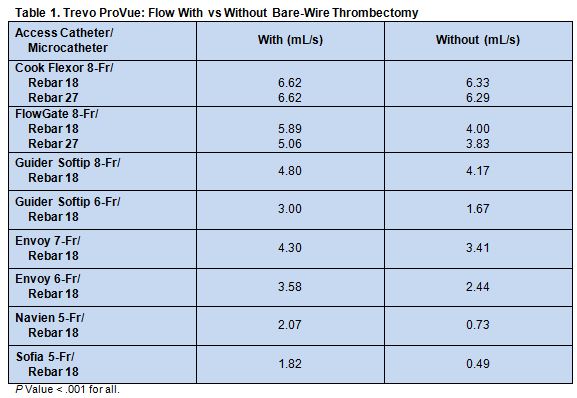Key Points:
- Study looks at in vitro and retrospective data on bare-wire thrombectomy technique
- Throughput is improved in vitro and outcomes were good in patients, with no thrombotic complications
During mechanical thrombectomy using stent retrievers, fully retracting the microcatheter out of the access catheter before thrombus retrieval can maximize aspiration, according to research published online April 15, 2016, ahead of print in the Journal of NeuroInterventional Surgery.
In an effort to maximize aspiration during endovascular stroke treatment using stent retrievers, Omid Nikoubashman, MD, of RWTH University Hospital Aachen (Aachen, Germany), and colleagues developed this technique, which they dub “bare-wire thrombectomy.” It is contrary to most stent retriever manufacturers’ directions of refraining from retracting the microcatheter further than the proximal stent-retriever markers.
“Even though the basic principle of thrombus removal with stent retrievers is well established, optimization of retrieval techniques may improve the effectiveness and efficiency of endovascular stroke treatment,” they stress.
The investigators used in vitro studies to determine whether bare-wire thrombectomy or manufacturers’ recommended techniques result in better throughput. They compared aspiration flow of water through various access catheters (5- to 8-Fr) with a Rebar microcatheter (0.18 inches and 0.27 inches, Covidien, MA) and a Trevo ProVue 4x20-mm stent retriever (Stryker, MI) using the standard technique and bare-wire thrombectomy.
The newer technique resulted in more aspiration flow through the access catheter in all tested settings. The difference in effect between the 2 techniques was most marked among catheters with a diameter of 7-Fr or less (table 1).
The investigators also retrospectively analyzed outcomes of 302 retrieval maneuvers using the bare-wire thrombectomy technique done in 117 patients between February 2010 and April 2015.
Among these patients, 91% achieved TICI ≥ 2b. No complications were reported.
“Our clinical experience shows that the BWT technique is effective and safe,” Dr. Nikoubashman and colleagues conclude. “The aim of future studies should be to evaluate whether increased aspiration also results in improved procedural and clinical outcome.”
Source:
- Nikoubashman O, Alt JP, Nikoubashman A, et al. Optimizing endovascular stroke treatment: removing the microcatheter before clot retrieval with stent-retrievers increases aspiration flow. J NeuroInterv Surg 2016;Epub ahead of print.
Disclosures:
- Dr. Nikoubashman reports no relevant conflicts of interest.



